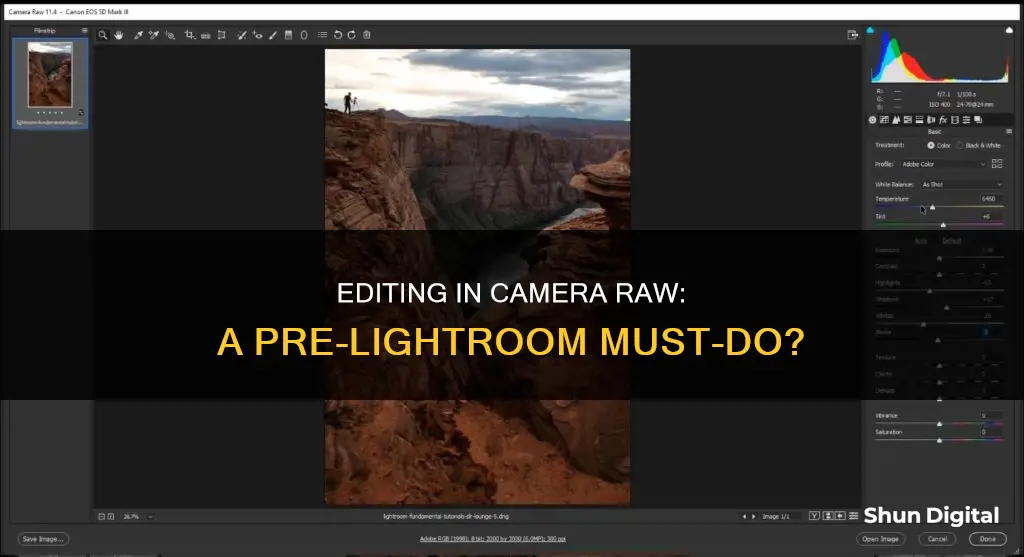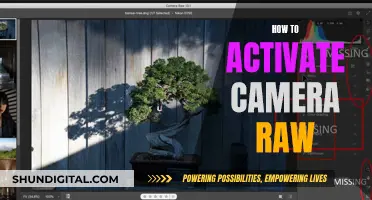
When it comes to editing your photos, the software you choose can significantly impact the final result. Adobe's Lightroom and Camera Raw (ACR) are two popular options, but how do you know which one is right for your needs?
Lightroom is a standalone program with an intuitive interface that makes it ideal for beginners. It offers robust organisational tools and is highly regarded for its printing features and seamless integration with Photoshop. On the other hand, Camera Raw is a plugin that requires a host program like Photoshop or Bridge. While it may be more challenging to learn, it is a powerful tool for editing RAW files and can be used as a filter in Photoshop.
Both programs share similar editing capabilities and the same RAW processing technology, so the choice between the two depends on your specific needs and workflow.
What You'll Learn
- Adobe Camera Raw is a plugin that needs to be hosted by another program like Photoshop, Photoshop Elements, Bridge, or After Effects
- Lightroom is a one-program solution for editing and file management
- You can use Camera Raw as a filter in Photoshop
- Camera Raw was launched in 2003 and Lightroom in 2007
- Both programs share the same RAW processing technology

Adobe Camera Raw is a plugin that needs to be hosted by another program like Photoshop, Photoshop Elements, Bridge, or After Effects
Adobe Camera Raw is a powerful plugin that requires a host program to run. This means that it needs to be used in conjunction with other software applications, such as Photoshop, Photoshop Elements, Bridge, or After Effects. These host programs provide the necessary environment for Adobe Camera Raw to function, allowing users to access and utilise its features.
Adobe Camera Raw is designed to work seamlessly with these host programs, offering advanced raw image processing capabilities. It provides users with a comprehensive set of tools for editing and enhancing raw image files, giving photographers greater control over their photographs. By working with raw data directly from the camera's sensor, Adobe Camera Raw enables users to achieve superior image quality and make precise adjustments to various aspects of their photos.
One of the key advantages of using Adobe Camera Raw is its compatibility with multiple Adobe applications. This flexibility gives users the option to choose the host program that best suits their workflow and specific editing needs. For example, Photoshop is widely used for more extensive photo editing tasks, while Bridge is ideal for users who prefer a file browser-based approach, similar to Lightroom.
It's important to note that each host program may offer a different version of the Adobe Camera Raw plugin, and updates may vary. As a result, users should ensure they are using a compatible version of the plugin with their chosen host application to avoid any issues or limitations.
By leveraging the capabilities of Adobe Camera Raw within these host programs, photographers and image editors can take full advantage of the raw format, unlocking the full potential of their images and achieving their desired results.
Mastin Labs and Adobe Camera Raw: A Perfect Match?
You may want to see also

Lightroom is a one-program solution for editing and file management
Lightroom is a powerful all-in-one photo management and editing solution. It is a non-destructive editor, meaning that any modifications made to an image can be reverted, and the original file remains unchanged. This is in contrast to a destructive editor like Photoshop, where changes are saved directly over the original image.
Lightroom is also a convenient solution for photographers. It is designed to be user-friendly, with a clear and efficient workspace, and is particularly good for managing large numbers of photos. It has advanced editing tools and is capable of handling RAW files, which can be imported and processed with ease.
Lightroom also has a mobile app, and cloud integration, allowing for efficient workflows when editing and organising images across multiple devices.
Lightroom is available as part of the Adobe Creative Cloud Photography Plan, which includes Photoshop, for $9.99 per month. This subscription model is a drawback for some users, who would prefer to buy the software outright. However, for those who are already subscribed to Adobe products, Lightroom is a natural addition to their workflow.
Lightroom is a popular choice for photographers, and for good reason. It is a comprehensive, efficient, and user-friendly solution for photo editing and management.
Finding the Camaro's Battery: Fifth Generation
You may want to see also

You can use Camera Raw as a filter in Photoshop
The Camera Raw filter is a powerful tool that offers access to the features of Adobe Camera Raw (ACR) in your Photoshop workflow. Essentially, this filter allows you to use the functions of the ACR interface within Photoshop. You can make adjustments within ACR at any time during your workflow, rather than limiting its usage to the RAW processing stage only.
To find the filter, select Filter > Camera Raw Filter, and the dialog box will pop up. Before you do this, you may want to stamp all the layers by pressing Ctrl/Cmd+Shift+Alt/Opt+E. This will combine all of your layers into a new layer from which you can work.
While the Camera Raw filter is a great tool, there are some limitations. You'll lose some functionality of the white balance adjustment in ACR because you're not working from a RAW file. The Crop and Rotate tools that you normally have access to when working on RAW files will also be unavailable. Additionally, there are a few options missing in the various menus of the Photoshop Camera Raw filter that you would normally see in ACR.
The process of using the Camera Raw filter in Photoshop will be more like editing a JPEG file in Lightroom or ACR. This means you'll have less information to work with, so it's important to get things as close to perfect as possible in the RAW stage of post-processing. That way, you'll have more versatility when using the filter in Photoshop.
- Fine-tune adjustments after RAW processing: If you change your mind about adjustments you made during the RAW processing stage, you can stamp the layers to a new layer and run the Camera Raw filter to make ACR-type adjustments without affecting your original work.
- Make trickier adjustments: The Camera Raw filter can be used to make adjustments that are difficult to replicate in Photoshop's main interface, such as using the Clarity tool or the Highlights, Whites, Darks, and Blacks sliders for global contrast adjustments.
- Apply local adjustments: You can make targeted adjustments to specific areas of your image, such as the background, and then use a layer mask to ensure they only affect the desired parts of the image.
- Add vignettes: The Vignette tool in the Camera Raw filter is easy, fast, and intuitive, making it hard to beat in Photoshop unless you need absolute control.
- Make final tweaks: Once you've finished processing your image in Photoshop, you can load up the Camera Raw filter to see if there are any small adjustments that can further enhance your image.
Charging for Cameras: How to Price Your Photography Equipment
You may want to see also

Camera Raw was launched in 2003 and Lightroom in 2007
Camera Raw and Lightroom are both Adobe photo-editing programs that allow you to process your photos and make adjustments to colour and exposure. They also allow you to correct perspective, fix lens distortions, and apply effects such as a vignette or split toning.
Lightroom is a standalone program, whereas Camera Raw is not. Camera Raw is a plugin that needs to be hosted by another program, such as Photoshop, Photoshop Elements, Bridge, or After Effects. Lightroom, on the other hand, is a one-program solution. It includes a library module, which Camera Raw does not have, and allows for file management as well as image manipulation. Lightroom also has more robust export tools than Camera Raw.
Another difference is in the way the two programs handle RAW files. Lightroom uses the same technology as Camera Raw to handle RAW files, so the results should be the same. However, Lightroom was not developed specifically for RAW files, whereas Camera Raw was created to open and edit RAW files and supports most RAW file formats.
In terms of image editing, both programs offer similar features, such as basic colour and exposure adjustments, cropping and rotating, removing spots, and correcting perspective and chromatic aberration. Lightroom has the added feature of allowing you to sync your edits across multiple photos, as well as saving your edits as presets. Camera Raw also allows you to batch edit and save edits as presets, but it does not have the sync feature.
When it comes to cost, both programs are part of Adobe's subscription service and can be accessed for $10 USD per month.
Cropping Camera Raw Like a Pro: Maintaining Aspect Ratio
You may want to see also

Both programs share the same RAW processing technology
Adobe Camera Raw (ACR) and Lightroom share the same RAW processing technology. ACR was first launched in 2003 to develop RAW files and can be supported by Photoshop, Photoshop Elements, Bridge, and After Effects. Lightroom, on the other hand, is a one-program solution and was based on ACR when it was released in 2007.
Both programs allow users to process their photos and make adjustments to colour and exposure. Users can also correct perspective, fix lens distortions, and apply effects such as a vignette or split toning. However, there are some differences between the two.
Lightroom is a standalone program with a user-friendly interface, whereas ACR cannot be downloaded and used on its own. Instead, it must be used through another Adobe app, such as Photoshop or Bridge. ACR is a plugin, whereas Lightroom is a full-fledged software program.
Lightroom has more advanced organisational tools than ACR, which is only for image manipulation and does not have file management features. Lightroom also has better print features than Photoshop and is designed to work seamlessly with it.
In conclusion, both programs have their strengths and can be used according to the needs of each project.
Charged Camera Batteries: Marking Them Efficiently
You may want to see also
Frequently asked questions
Camera Raw is a plugin that needs to be hosted by another program like Photoshop, Photoshop Elements, Bridge, or After Effects. Lightroom, on the other hand, is a one-program solution and a standalone program.
Camera Raw supports most raw file formats and can also be used to process other file formats such as JPEG and TIFF. It is also good for those who need to edit videos or do graphic design.
Lightroom is more user-friendly and has a smaller learning curve, making it a better option for beginner photographers. It also has better organizing tools and is ideal for event photographers who need to cull, keyword, and batch-edit large amounts of pictures. Lightroom also has unmatched print features and top-drawer sharing and mobile features.







